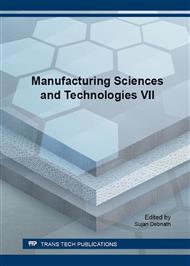[1]
O. Faruk, A. K. Bledzki, H. -P. Fink, and M. Sain, Biocomposites reinforced with natural fibers: 2000–2010, Progress in Polymer Science, vol. 37, pp.1552-1596, (2012).
DOI: 10.1016/j.progpolymsci.2012.04.003
Google Scholar
[2]
K. G. Satyanarayana, G. G. C. Arizaga, and F. Wypych, Biodegradable composites based on lignocellulosic fibers—An overview, Progress in Polymer Science, vol. 34, pp.982-1021, (2009).
DOI: 10.1016/j.progpolymsci.2008.12.002
Google Scholar
[3]
M. Asim, K. Abdan, M. Jawaid, M. Nasir, Z. Dashtizadeh, M. R. Ishak, et al., A Review on Pineapple Leaves Fibre and Its Composites, International Journal of Polymer Science, vol. 2015, pp.1-16, (2015).
DOI: 10.1155/2015/950567
Google Scholar
[4]
D. Liu, J. Song, D. P. Anderson, P. R. Chang, and Y. Hua, Bamboo fiber and its reinforced composites: structure and properties, Cellulose, vol. 19, pp.1449-1480, (2012).
DOI: 10.1007/s10570-012-9741-1
Google Scholar
[5]
R. Senawi, S. M. Alauddin, R. M. Saleh, and M. I. Shueb, Polylactic Acid/Empty Fruit Bunch Fiber Biocomposite: Influence of Alkaline and Silane Treatment on the Mechanical Properties, International Journal of Bioscience, Biochemistry and Bioinformatics, pp.59-61, (2013).
DOI: 10.7763/ijbbb.2013.v3.164
Google Scholar
[6]
J. G. Akpa and K. K. Dagde, Modification of Cassava Starch for Industrial Uses, International Journal of Engineering and Technology, vol. 2, (2012).
Google Scholar
[7]
H. T. Rett, Thermal and microscopic analysis of biodegradable laminates madefrom cassava flour, sorbitol and poly (butylene adipate-coterephthalate) PBAT, Acta Scientiarum. Technology, vol. 35, pp.765-770, (2013).
DOI: 10.4025/actascitechnol.v35i4.13183
Google Scholar
[8]
I. M. De Rosa, C. Santulli, and F. Sarasini, Mechanical and thermal characterization of epoxy composites reinforced with random and quasi-unidirectional untreated Phormium tenax leaf fibers, Materials & Design, vol. 31, pp.2397-2405, (2010).
DOI: 10.1016/j.matdes.2009.11.059
Google Scholar
[9]
N. Kengkhetkit and T. Amornsakchai, A new approach to "Greening" plastic composites using pineapple leaf waste for performance and cost effectiveness, Materials & Design, vol. 55, pp.292-299, 3/ (2014).
DOI: 10.1016/j.matdes.2013.10.005
Google Scholar
[10]
M. S. Alwani, H. P. S. A. Khalil, O. Sulaiman, M. N. Islam, and R. Dungani, An Approach to Using Agricultural Waste Fibres in Biocomposites Application: Thermogravimetric Analysis and Activation Energy Study, Bioresources, vol. 9, pp.218-230, (2014).
DOI: 10.15376/biores.9.1.218-230
Google Scholar
[11]
S. M. S. J. P. Siregar , M. Z. A. Rahman and H. M. D. K. Zaman, The effect of alkali treatment on the mechanical properties of short pineapple leaffibre (PALF) reinforced high impact polystyrene (HIPS) composites, ournal of Food, Agriculture & Environment vol. Vol. 8, p.5, (2010).
DOI: 10.1177/096369350901800104
Google Scholar
[12]
Y. A. El-Shekeil, S. M. Sapuan, A. Khalina, E. S. Zainudin, and O. M. Al-Shuja'a, Effect of alkali treatment on mechanical and thermal properties of Kenaf fiber-reinforced thermoplastic polyurethane composite, Journal of Thermal Analysis and Calorimetry, vol. 109, pp.1435-1443, (2012).
DOI: 10.1007/s10973-012-2258-x
Google Scholar
[13]
X. Li, L. G. Tabil, and S. Panigrahi, Chemical Treatments of Natural Fiber for Use in Natural Fiber-Reinforced Composites: A Review, Journal of Polymers and the Environment, vol. 15, pp.25-33, (2007).
DOI: 10.1007/s10924-006-0042-3
Google Scholar
[14]
S. Ikhlef, S. Nekkaa, M. Guessoum, and N. Haddaoui, Effects of Alkaline Treatment on the Mechanical and Rheological Properties of Low-Density Polyethylene/Spartium junceum Flour Composites, ISRN Polymer Science, vol. 2012, pp.1-7, (2012).
DOI: 10.5402/2012/965101
Google Scholar
[15]
Y. Du, N. Yan, and M. T. Kortschot, A simplified fabrication process for biofiber-reinforced polymer composites for automotive interior trim applications, Journal of Materials Science, vol. 49, pp.2630-2639, (2013).
DOI: 10.1007/s10853-013-7965-6
Google Scholar


